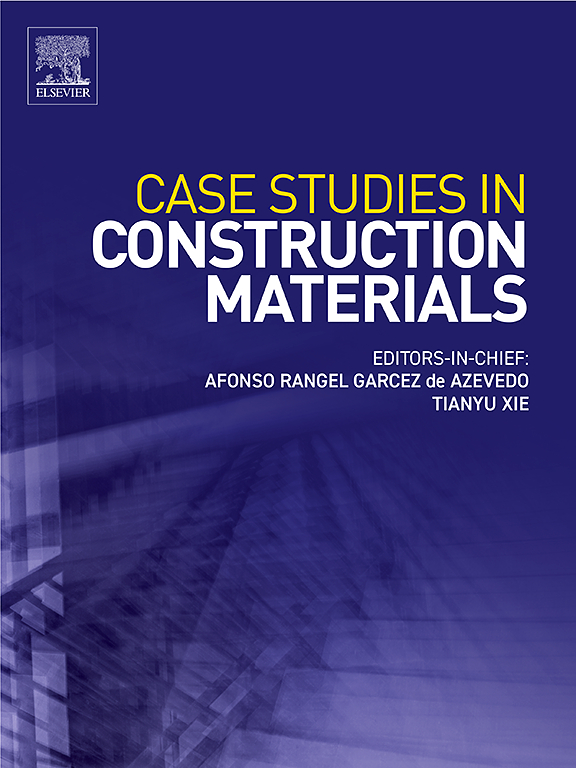Strength characteristics and microstructure of silty sand improved by red mud, lime and fly ash under dry-wet cycle
IF 6.5
2区 工程技术
Q1 CONSTRUCTION & BUILDING TECHNOLOGY
引用次数: 0
Abstract
Red mud is a kind of solid waste, which can be used as engineering roadbed filler after proper treatment. Due to the special physical and chemical properties of red mud, such as high liquid limit and high plasticity index, it may affect the stability of soil. Therefore, red mud can be improved by adding traditional inorganic binders such as lime and fly ash to improve its road performance as roadbed filler. Red mud-based modified silty sand subgrade filler will be affected by dry-wet alternation caused by various factors in practical application, thus affecting the durability of the material. In order to study the strength degradation characteristics and microstructure changes of red mud, lime and fly ash modified silty sand subgrade filler after dry-wet cycle, the samples of different curing ages were subjected to 0 ∼ 10 dry-wet cycles, and their compressive strength, microstructure and environmental control indexes were tested and analyzed. The results show that the sample cured for 90 days has the strongest toughness and the best ability to resist dry and wet deformation. With the increase of the number of dry-wet cycles, the mass loss rate of the sample is in the range of 6∼7 %, and the unconfined compressive properties and tensile properties decrease first and then increase. There are continuous hydration reactions and pozzolanic reactions in the soil, but the degree of physical damage in the early stage of the dry-wet cycle is large, and the later cementitious products have a certain offsetting effect on the structural damage. The internal cracks of the sample without dry-wet cycle are less and the structure is dense. After the dry-wet cycle, the microstructure of the sample changed greatly, and the cracks increased and showed different forms. Through SEM image analysis, it was found that the pore structure of the sample changed during the dry-wet cycle, which corresponded to the change law of mechanical properties. After wetting-drying cycles, the leaching concentration of heavy metals in the modified soil increased slightly, but the overall concentration value was low, which was not a toxic substance and could be used as a roadbed material. The study reveals the influence of dry-wet cycle on the strength characteristics and microstructure of red mud, lime and fly ash synergistically improved silty sand, which provides a technical reference for the engineering application of red mud-based materials.
干湿循环下赤泥、石灰和粉煤灰改性粉砂的强度特性及微观结构
赤泥是一种固体废弃物,经适当处理后可作为工程路基填料。由于赤泥具有高液限、高塑性指数等特殊的物理化学性质,可能会影响土壤的稳定性。因此,可以通过添加传统的无机粘结剂如石灰和粉煤灰来改善赤泥作为路基填料的路用性能。赤泥基改性粉砂路基填料在实际应用中会受到各种因素引起的干湿交替的影响,从而影响材料的耐久性。为研究赤泥、石灰和粉煤灰改性粉砂路基填料干湿循环后的强度退化特性和微观结构变化,对不同龄期的试样进行了0 ~ 10次干湿循环,并对其抗压强度、微观结构和环境控制指标进行了测试和分析。结果表明,固化90 d的试样韧性最强,抗干湿变形能力最好。随着干湿循环次数的增加,试样的质量损失率在6 ~ 7 %范围内,无侧限压缩性能和拉伸性能先减小后增大。土壤中存在连续的水化反应和火山灰反应,但干湿循环初期的物理损伤程度较大,后期的胶凝产物对结构损伤有一定的抵消作用。无干湿循环的试样内部裂纹较少,组织致密。干湿循环后,试样的微观结构发生了较大的变化,裂纹增多并呈现不同的形式。通过SEM图像分析发现,在干湿循环过程中,试样的孔隙结构发生了变化,与力学性能的变化规律相对应。经过干湿循环后,改性土中重金属浸出浓度略有升高,但总体浓化值较低,不属于有毒物质,可作为路基材料使用。研究揭示了干湿循环对赤泥、石灰、粉煤灰协同改性粉砂强度特性和微观结构的影响,为赤泥基材料的工程应用提供了技术参考。
本文章由计算机程序翻译,如有差异,请以英文原文为准。
求助全文
约1分钟内获得全文
求助全文
来源期刊

Case Studies in Construction Materials
Multiple-
CiteScore
7.60
自引率
19.40%
发文量
842
审稿时长
63 days
期刊介绍:
Case Studies in Construction Materials provides a forum for the rapid publication of short, structured Case Studies on construction materials. In addition, the journal also publishes related Short Communications, Full length research article and Comprehensive review papers (by invitation).
The journal will provide an essential compendium of case studies for practicing engineers, designers, researchers and other practitioners who are interested in all aspects construction materials. The journal will publish new and novel case studies, but will also provide a forum for the publication of high quality descriptions of classic construction material problems and solutions.
 求助内容:
求助内容: 应助结果提醒方式:
应助结果提醒方式:


